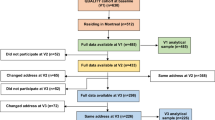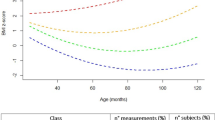Abstract
Objective:
The main objective of this study was to investigate whether children's perceptions of neighborhood safety are associated with their weight status and weight-related behaviors, independently of their parents' perceptions.
Methods:
Data were from the baseline wave (collected in 2005–2008) of the Quebec Adipose and Lifestyle Investigation in Youth (QUALITY), an ongoing prospective study of 630 children aged 8–10 years (from Quebec, Canada) at risk of obesity. Weight and height were measured, and World Health Orgaization age- and sex-specific body mass index (BMI) z-scores were computed. Physical activity was measured by accelerometry, and time spent watching television, playing computer and video games during week and weekend days was self-reported. Structural equation modeling was used to simultaneously estimate the associations between parent and child perceived safety, with children's BMI z-score, physical activity and screen time.
Results:
The results suggest that, when parent perceived safety was at the mean, children who perceived their neighborhood as being safest had nearly an additional 70 daily activity counts per minute (representing an ~10% increase in overall physical activity level) compared with children who perceived it as being least safe. Among children who perceived a mean level of safety, those whose parents perceived their neighborhood as being safest spent approximately an hour less per day in front of screens compared with those whose parents perceived their neighborhood as being least safe. Parent and child perceptions of safety both indirectly contribute to children's weight status by differentially impacting weight-related behaviors.
Conclusion:
Findings indicate that targeting both parent and child perceived neighborhood safety could bolster efforts to promote healthy weight and weight-related behaviors among children.
This is a preview of subscription content, access via your institution
Access options
Subscribe to this journal
Receive 12 print issues and online access
$259.00 per year
only $21.58 per issue
Buy this article
- Purchase on SpringerLink
- Instant access to full article PDF
Prices may be subject to local taxes which are calculated during checkout



Similar content being viewed by others
References
Statistics Canada Canadian Health Measures Survey: Cycle 2 Data Tables 2009 to 2011. Statistics Canada: Ottawa, Canada, 2013.
Shields M . Overweight and obesity among children and youth. Health Rep 2006; 17: 27–42.
Mark AE, Boyce WF, Janssen I . Television viewing, computer use and total screen time in Canadian youth. Paediatr Child Health 2006; 11: 595.
Tremblay MS, Warburton DE, Janssen I, Paterson DH, Latimer AE, Rhodes RE et al. New Canadian physical activity guidelines. Appl Physiol Nutr Metab 2011; 36: 36–46.
Colley RC, Garriguet D, Janssen I, Craig CL, Clarke J, Tremblay MS . Physical activity of Canadian children and youth: accelerometer results from the 2007 to 2009 Canadian Health Measures Survey. Health Rep 2011; 22: 15–23.
Booth KM, Pinkston MM, Poston WS . Obesity and the built environment. J Am Diet Assoc 2005; 105: S110–S117.
Carroll-Scott A, Gilstad-Hayden K, Rosenthal L, Peters SM, McCaslin C, Joyce R et al. Disentangling neighborhood contextual associations with child body mass index, diet, and physical activity: the role of built, socioeconomic, and social environments. Soc Sci Med 2013; 95: 106–114.
Schoeppe S, Braubach M . Tackling Obesity by Creating Healthy Residential Environments. World Health Organization: Geneva, Switzerland, 2007.
Carver A, Timperio A, Crawford D . Playing it safe: the influence of neighbourhood safety on children's physical activity: A review. Health Place 2008; 14: 217–227.
Bacha JM, Appugliese D, Coleman S, Kaciroti N, Bradley RH, Corwyn RF et al. Maternal perception of neighborhood safety as a predictor of child weight status: The moderating effect of gender and assessment of potential mediators. Int J Pediatr Obes 2010; 5: 72–79.
Foster S, Giles-Corti B . The built environment, neighborhood crime and constrained physical activity: an exploration of inconsistent findings. Prev Med 2008; 47: 241–251.
Gray E, Jackson J, Farrall S . Reassessing the fear of crime. Eur J Criminol 2008; 5: 363–380.
Daniel M, Moore S, Kestens Y . Framing the biosocial pathways underlying associations between place and cardiometabolic disease. Health Place 2008; 14: 117–132.
Certain LK, Kahn RS . Prevalence, correlates, and trajectory of television viewing among infants and toddlers. Pediatrics 2002; 109: 634–642.
Carson V, Janssen I . Neighborhood disorder and screen time among 10-16 year old Canadian youth: a cross-sectional study. Int J Behav Nutr Phys Act 2012; 9: 66.
Veugelers P, Sithole F, Zhang S, Muhajarine N . Neighborhood characteristics in relation to diet, physical activity and overweight of Canadian children. Int J Pediatr Obes 2008; 3: 152–159.
Weir LA, Etelson D, Brand DA . Parents' perceptions of neighborhood safety and children's physical activity. Prev Med 2006; 43: 212–217.
Ding D, Bracy NL, Sallis JF, Saelens BE, Norman GJ, Harris SK et al. Is fear of strangers related to physical activity among youth? Am J Health Promot 2012; 26: 189–195.
Datar A, Nicosia N, Shier V . Parent perceptions of neighborhood safety and children's physical activity, sedentary behavior, and obesity: evidence from a national longitudinal study. Am J Epidemiol 2013; 177: 1065–1073.
Burdette HL, Whitaker RC . A national study of neighborhood safety, outdoor play, television viewing, and obesity in preschool children. Pediatrics 2005; 116: 657–662.
Ding D, Sallis JF, Kerr J, Lee S, Rosenberg DE . Neighborhood environment and physical activity among youth: a review. Am J Prev Med 2011; 41: 442–455.
Christian H, Giles-Corti B, Knuiman M, Timperio A, Foster S . The influence of the built environment, social environment and health behaviors on body mass index. Results from RESIDE. Prev Med 2011; 53: 57–60.
Eccles JS . The development of children ages 6 to 14. Fut Child 1999; 9: 30–44.
Chandola T . The fear of crime and area differences in health. Health Place 2001; 7: 105–116.
Goodman E, Whitaker RC . A prospective study of the role of depression in the development and persistence of adolescent obesity. Pediatrics 2002; 110: 497–504.
Hill TD, Ross CE, Angel RJ . Neighborhood disorder, psychophysiological distress, and health. J Health Soc Behav 2005; 46: 170–186.
Lambert M, Van Hulst A, O'Loughlin J, Tremblay A, Barnett TA, Charron H et al. Cohort profile: the Quebec Adipose and Lifestyle Investigation in youth cohort. Int J Epidemiol 2011; 41: 1533–1544.
Lubans DR, Hesketh K, Cliff D, Barnett L, Salmon J, Dollman J et al. A systematic review of the validity and reliability of sedentary behaviour measures used with children and adolescents. Obes Rev 2011; 12: 781–799.
Chaput J-P, Saunders TJ, Mathieu M-È, Henderson M, Tremblay MS, O'Loughlin J et al. Combined associations between moderate to vigorous physical activity and sedentary behaviour with cardiometabolic risk factors in children. Appl Physiol Nutr Metab 2013; 38: 477–483.
Ekelund U, Luan J, Sherar LB, Esliger DW, Griew P, Cooper A et al. Moderate to vigorous physical activity and sedentary time and cardiometabolic risk factors in children and adolescents. JAMA 2012; 307: 704–712.
Gullone E . The development of normal fear: a century of research. Clin Psychol Rev 2000; 20: 429–451.
Côté-Lussier C, Jackson J, Kestens Y, Henderson M, Barnett T . A child’s view: social and physical environmental features differentially predict parent and child perceived neighborhood safety. J Urban Health 2015; 92: 10–23.
Cutting TM, Fisher JO, Grimm-Thomas K, Birch LL . Like mother, like daughter: familial patterns of overweight are mediated by mothers' dietary disinhibition. Am J Clin Nutr 1999; 69: 608–613.
Wrotniak BH, Epstein LH, Paluch RA, Roemmich JN . Parent weight change as a predictor of child weight change in family-based behavioral obesity treatment. Arch Pediatr Adolesc Med 2004; 158: 342–347.
Warren R . Parental mediation of children's television viewing in low-income families. J Commun 2005; 55: 847–863.
Byrne BM . Structural Equation Modeling with Mplus: Basic Concepts, Applications, and Programming. Routledge: New York, NY, USA, 2013.
Salmon J, Timperio A, Telford A, Carver A, Crawford D . Association of family environment with children's television viewing and with low level of physical activity. Obes Res 2005; 13: 1939–1951.
Dössegger A, Ruch N, Jimmy G, Braun-Fahrländer C, Mäder U, Hänggi J et al. Reactivity to accelerometer measurement of children and adolescents. Med Sci Sports Exerc 2014; 46: 1140–1146.
Troiano RP, Berrigan D, Dodd KW, Mâsse LC, Tilert T, McDowell M . Physical activity in the United States measured by accelerometer. Med Sci Sports Exerc 2008; 40: 181.
Anderson SE, Economos CD, Must A . Active play and screen time in US children aged 4 to 11 years in relation to sociodemographic and weight status characteristics: a nationally representative cross-sectional analysis. BMC Public Health 2008; 8: 366.
Timperio A, Crawford D, Telford A, Salmon J . Perceptions about the local neighborhood and walking and cycling among children. Prev Med 2004; 38: 39–47.
Lorenc T, Clayton S, Neary D, Whitehead M, Petticrew M, Thomson H et al. Crime, fear of crime, environment, and mental health and wellbeing: mapping review of theories and causal pathways. Health Place 2012; 18: 757–765.
Duncan SC, Seeley JR, Gau JM, Strycker LA, Farmer RF . A latent growth model of adolescent physical activity as a function of depressive symptoms. Ment Health Phys Act 2012; 5: 57–65.
Stavrakakis N, de Jonge P, Ormel J, Oldehinkel AJ . Bidirectional prospective associations between physical activity and depressive symptoms. The TRAILS Study. J Adolesc Health 2012; 50: 503–508.
Pantazis C . 'Fear of crime’, vulnerability and poverty. Br J Criminol 2000; 40: 414–436.
Lovasi GS, Hutson MA, Guerra M, Neckerman KM . Built environments and obesity in disadvantaged populations. Epidemiol Rev 2009; 31: 7–20.
Jackson J, Stafford M . Public health and fear of crime a prospective cohort study. Br J Criminol 2009; 49: 832–847.
Van Hulst A, Gauvin L, Kestens Y, Barnett T . Neighborhood built and social environment characteristics: a multilevel analysis of associations with obesity among children and their parents. Int J Obes (Lond) 2013; 37: 1328–1335.
Public Health Agency of Canada. Tips to Get Active: Physical Activity Tips for Children (5–11 years). Available at: http://www.phac-aspc.gc.ca/hp-ps/hl-mvs/pa-ap/05paap-eng.php Accessed 5 June 2015.
Austin DM, Furr LA, Spine M . The effects of neighborhood conditions on perceptions of safety. J Crim Justice 2002; 30: 417–427.
Jackson J . Experience and expression social and cultural significance in the fear of crime. Br J Criminol 2004; 44: 946–966.
Kuo FE, Bacaicoa M, Sullivan WC . Transforming inner-city landscapes trees, sense of safety, and preference. Environ Behav 1998; 30: 28–59.
Boreham C, Riddoch C . The physical activity, fitness and health of children. J Sports Sci 2001; 19: 915–929.
Acknowledgements
We acknowledge the funding agencies of the QUALITY cohort: the Canadian Institutes of Health Research, the Heart and Stroke Foundation of Canada and the Fonds de la recherche en santé du Québec. Dr Marie Lambert (July 1952–February 2012), pediatric geneticist and researcher, initiated the QUALITY cohort. Her leadership and devotion to QUALITY will always be remembered and appreciated.
Author information
Authors and Affiliations
Corresponding author
Ethics declarations
Competing interests
The authors declare no conflict of interest.
Rights and permissions
About this article
Cite this article
Côté-Lussier, C., Mathieu, MÈ. & Barnett, T. Independent associations between child and parent perceived neighborhood safety, child screen time, physical activity and BMI: a structural equation modeling approach. Int J Obes 39, 1475–1481 (2015). https://doi.org/10.1038/ijo.2015.98
Received:
Accepted:
Published:
Issue date:
DOI: https://doi.org/10.1038/ijo.2015.98
This article is cited by
-
Association between built environments and weight status: evidence from longitudinal data of 9589 Australian children
International Journal of Obesity (2022)
-
Reciprocal relationships between employment status and psychological symptoms: findings from the Building a New Life in Australia study
Social Psychiatry and Psychiatric Epidemiology (2022)



